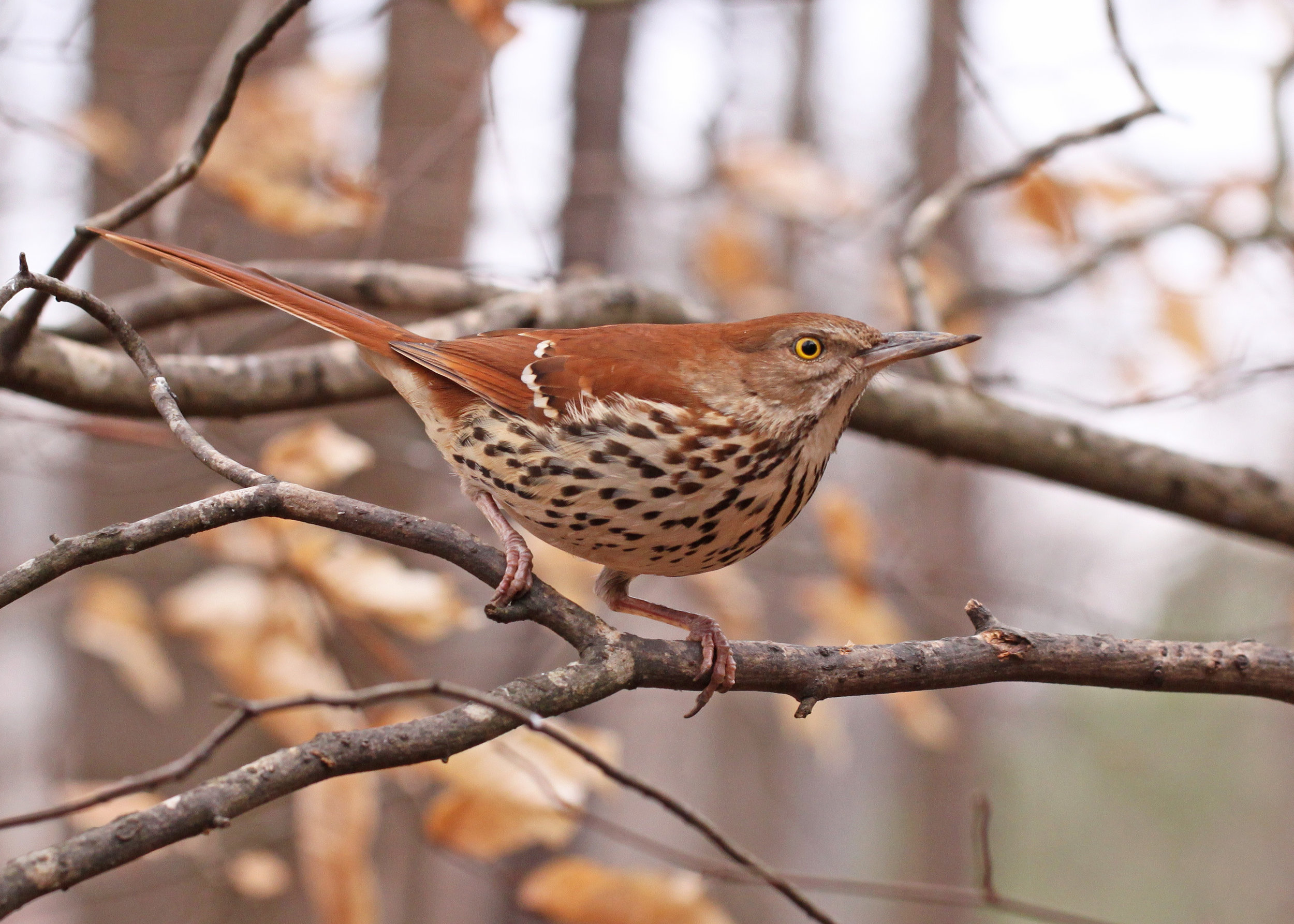Photo by Vicki Deloach
Cutting brush along the pond at the Laas acquisition a few weeks back, I stopped for a minute while I filled the brush cutter with gas. As the tank gurgled with fuel, I heard a sound nearby—two squawking notes—which I thought might be a blue jay. Tracing the source of the call led me to a rufous-backed bird with black streaks on its breast and a slightly curved bill. My winter birding brain didn't quite compute initially, but I soon realized I had a brown thrasher in front of me.
Thrasher is a fantastic name for the bird, which you can see when it thrashes through its brushy habitat. When flushed, the brown thrasher will often drop to the ground and scamper through a tangle of dogwood, briar, and likely some non-native honeysuckle. For these habits, I think of the brown thrasher as a rather messy and unkempt bird. Its yellow eyes seem fierce in an insane sort of way, and the twice repeated notes of its song give the thrasher a digressive voice.
But this is a beautiful bird, its rusty feathers occupying an under appreciated habitat (shrublands), and just because its shrubby labyrinths aren't usually accessible to humans doesn't mean we can't appreciate the thrasher.
We'll start with the song of the brown thrasher, and really it's unfair to the thrasher to call it a singular song. The bird has over 1,000 songs in its repertoire, with some research claiming the birds have at least 3,000 song phrases. Its calls and songs are thought to be more diverse than the related Northern Mockingbird, though the mockingbird will mimic a wider variety of birds. Nonetheless, brown thrashers will mimic tufted titmice, cardinals, flickers, and wood thrushes, among many others.
These are intelligent birds who've been known to hammer acorns and other nuts after they wedge them in a hole or under a rock. In 1841, The Birds of Massachusetts called the brown thrasher “superior to all the birds of its class... in matter of strength and intelligence,” and reported that hand-reared birds would take tough bread crumbs and soak them in water, or remove the stingers of wasps before eating.
Photo by Shawn Taylor
Additionally, the brown thrasher helps disperse seed on account of being a frugivore, and outside of the breeding season the bird focuses on fruits, nuts, and seeds. During the breeding season, arthropods are a major component of the diet due to superior protein content. The consumption and digestion of fruits may increase germination rates in some species of plants; one study found that pokeweed germinates faster when digested by brown thrashers as compared to undigested seeds.
This overwintering thrasher at Faville Grove is quite the anomaly. In Wisconsin Birdlife, Sam Robbins notes that no thrashers were reported to overwinter during the 19th century, but sporadic reports began in 1913 and have continued since. Robbins suggested that these birds tended to overwinter at feeders, while the bird at Faville Grove doesn't appear to have access to a feeder. On eBird last month, only one other bird had been reported in the state, near Wausau, frequenting a yard feeder.
I can only guess at the diet of this bird, but it likely consists of any arthropods that might jaunt out on a warm day. This bird has survived some severely cold weather thus far, and might be fit to survive the winter. Its diet of fruits could be quite varied and consist of such delicacies like: bittersweet, juniper berries, hackberry, poison ivy berries, sumac, winterberry, hawthorn, or nannyberry. Nearby lowland areas have rich thickets of winterberry, which could provide ample food, and some large oaks around the pond have the bittersweet vines, with berries still present.
Photo by Hoan Luong
In south Texas, overwintering birds establish territories, a behavior normally associated with short-distance migrants or birds that stay put for the winter. There, brown thrashers compete with long-billed and curve-billed thrashers and will aggressively defend riparian brushlands rich in arthropods. Without sympatric species at Faville Grove, this brown thrasher won't have to fight much to defend its habitat, but finding food over the rest of winter could prove a challenge as this bird awaits the rest of its Toxostoma brethren, scheduled for a return flight in late April.
Written by Drew Harry, Faville Grove Sanctuary land steward






